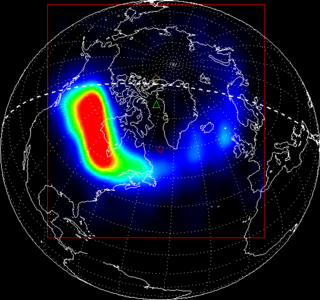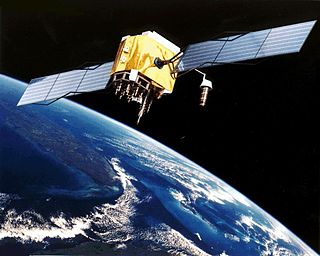The Index is a standard index used to measure ionospheric disturbances. It is defined as the ratio of the standard deviation of signal intensity to the average signal intensity. [1]
The Index is a standard index used to measure ionospheric disturbances. It is defined as the ratio of the standard deviation of signal intensity to the average signal intensity. [1]
This parameter is displayed in real time by many institutions:

The ionosphere is the ionized part of the upper atmosphere of Earth, from about 48 km (30 mi) to 965 km (600 mi) above sea level, a region that includes the thermosphere and parts of the mesosphere and exosphere. The ionosphere is ionized by solar radiation. It plays an important role in atmospheric electricity and forms the inner edge of the magnetosphere. It has practical importance because, among other functions, it influences radio propagation to distant places on Earth.

In optics, the refractive index of an optical medium is a dimensionless number that gives the indication of the light bending ability of that medium.
In telecommunication, the term critical frequency has the following meanings:
In telecommunication and radio science, an ionospheric sounding is a technique that provides real-time data on high-frequency ionospheric-dependent radio propagation, using a basic system consisting of a synchronized transmitter and receiver.
In telecommunication, a hop is a portion of a signal's journey from source to receiver. Examples include:

The High-frequency Active Auroral Research Program (HAARP) was initiated as an ionospheric research program jointly funded by the U.S. Air Force, the U.S. Navy, the University of Alaska Fairbanks, and the Defense Advanced Research Projects Agency (DARPA). It was designed and built by BAE Advanced Technologies. Its original purpose was to analyze the ionosphere and investigate the potential for developing ionospheric enhancement technology for radio communications and surveillance. Since 2015 it has been operated by the University of Alaska Fairbanks.

Space weather is a branch of space physics and aeronomy, or heliophysics, concerned with the time varying conditions within the Solar System, including the solar wind, emphasizing the space surrounding the Earth, including conditions in the magnetosphere, ionosphere, thermosphere, and exosphere. Space weather is distinct from but conceptually related to the terrestrial weather of the atmosphere of Earth. The term space weather was first used in the 1950s and came into common usage in the 1990s. Later, it was generalized to a "Space Climate" research discipline which focuses on general behaviors of longer and larger-scale variabilities and effects.

A geomagnetic storm, also known as a magnetic storm, is a temporary disturbance of the Earth's magnetosphere caused by a solar wind shock wave and/or cloud of magnetic field that interacts with the Earth's magnetic field.
Anomalous propagation includes different forms of radio propagation due to an unusual distribution of temperature and humidity with height in the atmosphere. While this includes propagation with larger losses than in a standard atmosphere, in practical applications it is most often meant to refer to cases when signal propagates beyond normal radio horizon.

The Schumann resonances (SR) are a set of spectrum peaks in the extremely low frequency (ELF) portion of the Earth's electromagnetic field spectrum. Schumann resonances are global electromagnetic resonances, generated and excited by lightning discharges in the cavity formed by the Earth's surface and the ionosphere.

Sir Edward Victor Appleton was an English physicist, Nobel Prize winner (1947) and pioneer in radiophysics. He studied, and was also employed as a lab technician, at Bradford College from 1909 to 1911.
Incoherent scattering is a type of scattering phenomenon in physics. The term is most commonly used when referring to the scattering of an electromagnetic wave by random fluctuations in a gas of particles.
The lowest usable high frequency (LUF), in radio transmission, is a frequency in the HF band at which the received field intensity is sufficient to provide the required signal-to-noise ratio for a specified time period, e.g., 0100 to 0200 UTC, on 90% of the undisturbed days of the month. Any frequency lower than this is not able to fulfil those requirements, while higher frequencies usually yield better result until the maximum usable frequency is reached. The amount of energy absorbed by the lower regions of the ionosphere directly impacts the LUF.
In physics, ray tracing is a method for calculating the path of waves or particles through a system with regions of varying propagation velocity, absorption characteristics, and reflecting surfaces. Under these circumstances, wavefronts may bend, change direction, or reflect off surfaces, complicating analysis. Ray tracing solves the problem by repeatedly advancing idealized narrow beams called rays through the medium by discrete amounts. Simple problems can be analyzed by propagating a few rays using simple mathematics. More detailed analysis can be performed by using a computer to propagate many rays.
This is an index to articles about terms used in discussion of radio propagation.

Ionospheric storms are storms which contain varying densities of energised electrons produced from the sun. They are categorised into positive and negative storms, where positive storms have a high density of electrons and negative storms contain a lower density. This is measured in total electron content (TEC), and is a key variable used in data to record and compare the intensities of ionospheric storms. Ionospheric storms are caused by geomagnetic storms.
Signal-to-noise ratio (SNR) is used in imaging to characterize image quality. The sensitivity of a imaging system is typically described in the terms of the signal level that yields a threshold level of SNR.
In astronomy, interplanetary scintillation refers to random fluctuations in the intensity of radio waves of celestial origin, on the timescale of a few seconds. It is analogous to the twinkling one sees looking at stars in the sky at night, but in the radio part of the electromagnetic spectrum rather than the visible one. Interplanetary scintillation is the result of radio waves traveling through fluctuations in the density of the electron and protons that make up the solar wind.

The error analysis for the Global Positioning System is important for understanding how GPS works, and for knowing what magnitude of error should be expected. The GPS makes corrections for receiver clock errors and other effects but there are still residual errors which are not corrected. GPS receiver position is computed based on data received from the satellites. Errors depend on geometric dilution of precision and the sources listed in the table below.

Multidimensional Poverty Indices use a range of indicators to calculate a summary poverty figure for a given population, in which a larger figure indicates a higher level of poverty. This figure considers both the proportion of the population that is deemed poor, and the 'breadth' of poverty experienced by these 'poor' households, following the Alkire & Foster 'counting method'. The method was developed following increased criticism of monetary and consumption based poverty measures, seeking to capture the deprivations in non-monetary factors that contribute towards well-being. While there is a standard set of indicators, dimensions, cutoffs & thresholds used for a 'Global MPI', the method is flexible and there are many examples of poverty studies that modify it to best suit their environment. The methodology has been mainly, but not exclusively, applied to developing countries.